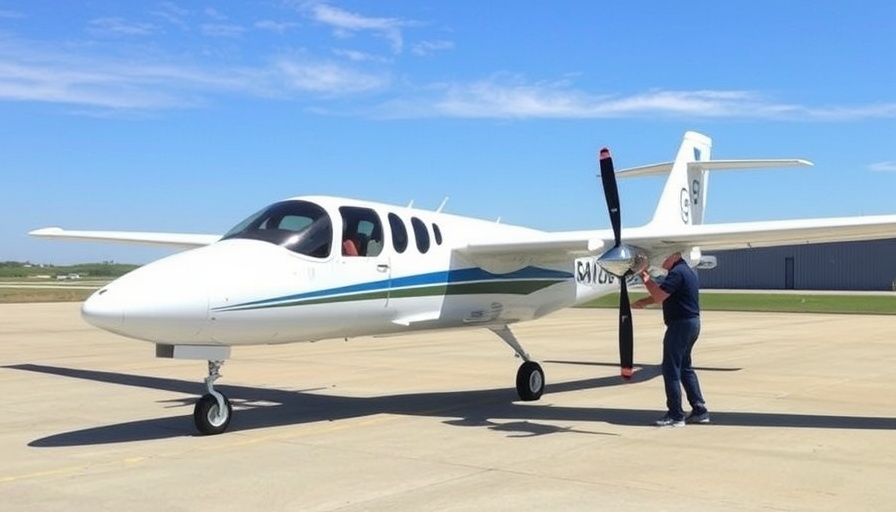
The Future of Aviation is Hybrid-Electric
In recent years, electric and hybrid-electric aircraft have moved from the realm of theory into practical applications, transforming the landscape of aviation technology. The latest venture into this airspace is being spearheaded by General Atomics Aeronautical Systems Inc. (GA-ASI), which has recently secured a $99.3 million contract from the U.S. Air Force to develop a hybrid-electric aircraft. This ambitious initiative emphasizes the growing interest in sustainable aviation technologies within the defense sector.
GA-ASI's Bold Step in Aviation Technology
Located in Poway, California, GA-ASI is renowned for its remotely piloted military aircraft powered by traditional fuel. However, the new contract signifies a pivotal shift toward innovation. Dubbed the GHOST, this hybrid-electric aircraft is poised to serve dual purposes in intelligence and surveillance operations alongside strike capabilities. The contract was awarded through a sole-source acquisition, which underscores the strategic importance the Pentagon places on advancing these technologies to ensure operational advantages in contested environments.
A Closer Look at Hybrid-Electric Aircraft
But what distinguishes hybrid-electric aircraft from their fully electric counterparts? A hybrid-electric system combines traditional jet propulsion with electric motors, which can enhance efficiency and reduce operational costs. For instance, a hybrid-electric aircraft can operate using a combination of batteries and a conventional engine, allowing for extended flight ranges and lower emissions. As noted by GA-ASI executives in past discussions, the integration of ducted fans connected via "serpentine" inlets is supposed to render these aircraft less detectable to adversaries, enhancing their stealthy characteristics.
Impact on Local Economy in Bakersfield, CA
The development of hybrid-electric aircraft is not just a boon for the aerospace sector; it strengthens the local economies in regions like Bakersfield. As companies like GA-ASI expand their capabilities, they create jobs and foster technological advancements that resonate within the community. Such projects can prompt investment in education and training programs to prepare a skilled workforce, ensuring that residents are equipped for careers in an evolving industry.
Global Trends in Aviation Sustainability
Simultaneously, this project aligns with global trends towards sustainability in aviation. With climate change concerns pushing for greener technologies, various companies, including Beta Technologies, are already showcasing the effectiveness of electric aircraft. Their all-electric success story of transporting five people from East Hampton, NY, to JFK International Airport illustrates that electric aviation isn't just a concept but a tangible reality. The development of these technologies could result in significant reductions in carbon footprints and noise pollution, addressing public concerns about air travel.
What Lies Ahead for GA-ASI's Hybrid Aircraft?
Founded with the intent to innovate, GA-ASI's hybrid-electric aircraft project is expected to conclude by August 2028. As advancements continue, we may witness a pivotal moment in which military aviation technology not only revolutionizes defense operations but also impacts commercial air travel. Bargains for energy efficiency and sustainability in current and future projects will undoubtedly drive aviation innovation and operational efficacy.
Engaging with the Community
For residents of Bakersfield and beyond, the advancements in hybrid-electric technology represent not just a glimpse into the future of aviation but also an opportunity for economic and educational growth. As we look towards the horizon of this technological shift, it becomes imperative for the local community to engage with these developments and recognize their potential impacts.
In conclusion, as GA-ASI embarks on this extraordinary journey into hybrid-electric aviation, it promises to revolutionize both military and commercial flying. By fostering technological advancements and engaging local communities, we stand at the cusp of a new aviation era.
To stay informed about advancements in aviation and technology, that could reshape our approach to sustainable solutions, consider exploring educational opportunities and advocacy initiatives in your area. The flourishing intersection of aerospace innovation and public discourse heralds a future fueled by creativity and collective progress.
 Add Row
Add Row  Add
Add 



Write A Comment